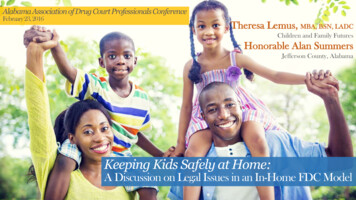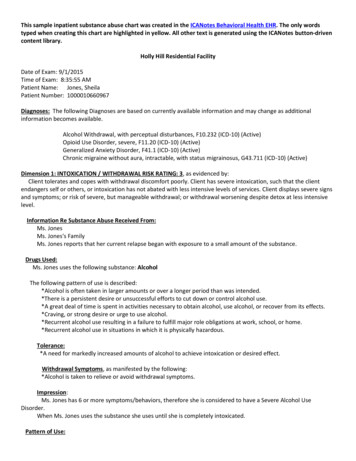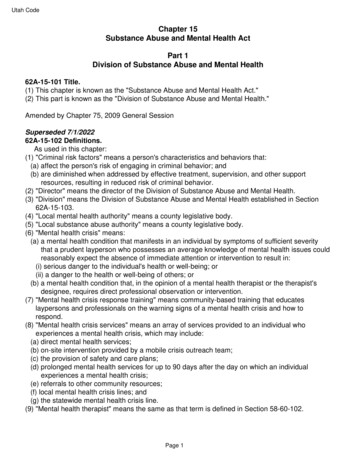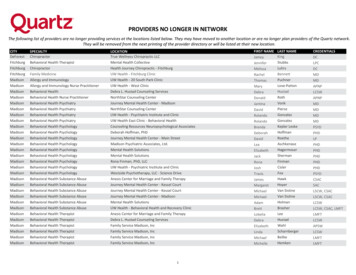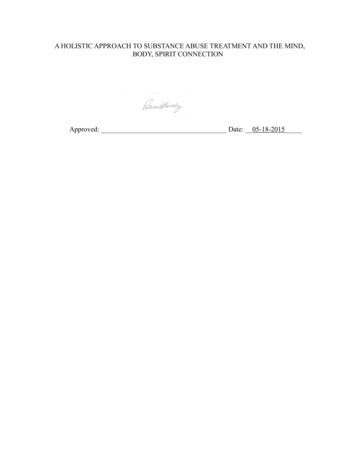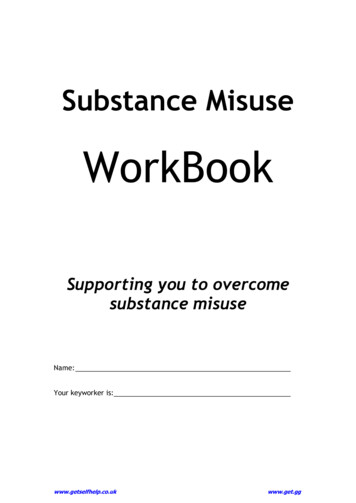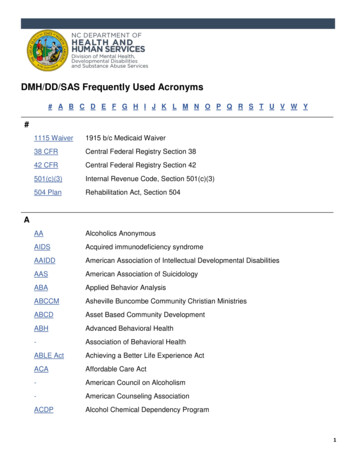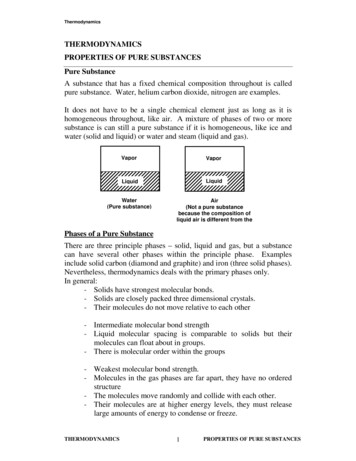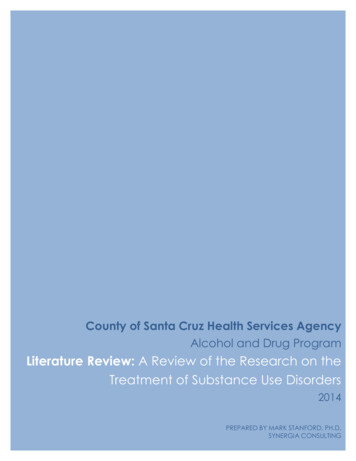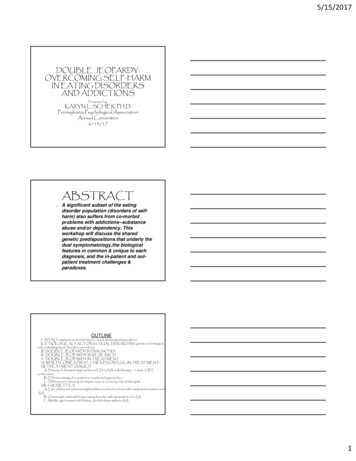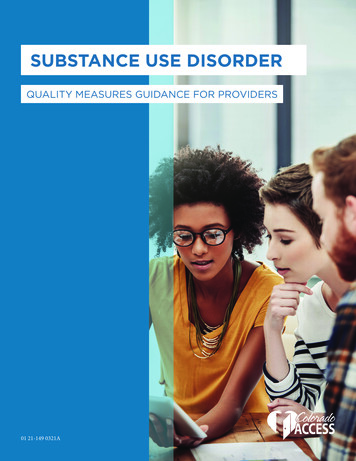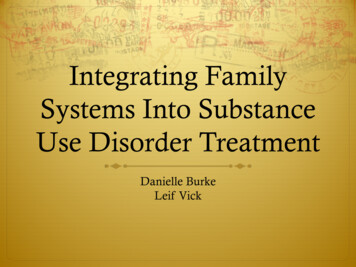
Transcription
Integrating FamilySystems Into SubstanceUse Disorder TreatmentDanielle BurkeLeif Vick
Presentation Overview Introduction of problem of substance use Specific treatment Why families are not incorporated Family theory What is currently being used Cost effectiveness Conclusion
Substance Use Disorders DSM-5 Nationwide issue Cultural aspects Cost of substance use(American Psychiatric Association, 2013; ChiaChen Chen, Gance-Cleveland, Kopak, Haas, &Gillmore, 2010; Kelly, 2016; NIH, 2015; Pacek,Malcom, & Martins, 2012; SAMHSA, 2015),
Specific Treatments Substance use impact on family ASAM Dimensions Abstinence versus harm reduction TraumaAmerican Psychiatric Association, 2013; American Society of AddictionMedicine, n.d ; Blume & Lovato, 2010; Copello, 2010; Daley, 2013;Denning, 2010; Downs, Seedall, Taylor, & Downs, 2015; Fals-Stewart etal., 2009; Giordano, Ohlsson, Kendler, Sundquist, & Sundquist, 2014;Hedges, 2011; Hussaarts, Roozen, Meyers, van de Wetering, & McCrady,2011; Kelly, 2016; MacMaster, 2004; McKeganey, 2012; Oliveros &Kaufman, 2011; Platter & Kelley, 2012; Rosenberg, 2011; Rowe, 2010;Taplin, Saddichha, Li, & Krausz, 2014; Zweben et al., 2015
Family Theory Homeostasis Systems Theory Systemic Motivational Theory Benefits of involving family in substance use treatmentBertrand et al., 2013; Copello, 2010; Denning, 2010; Downs et al.,2015; Fals-Stewart et al., 2009; Kelly, 2016; McGoldrick, Giordano,& Garcia-Preto, 2005; Nicholas, 2013; O’Farrell & Fals-Stewart,2006; Platter & Kelley, 2012; Ruff et al., 2010; Steinglass, 2009
Why are families notbeing used in substanceuse disorder treatment?American Psychological Association, 2015; Corey, Corey, & Callahan, 2011; Hussaarts et al., 2011; Whittinghill, 2002; Wisdom, Cavaleri, Gogel, & Nacht, 2011
Interventions UsingFamily Systemic Motivational Therapy Motivational Interviewing with family Behavioral Couples Therapy CRAFT Relapse PreventionAlcoholism & Drug Abuse Weekly, 2015; ASAM, 2011;Clarke & Myers, 2012; Copello, 2010; Denning, 2010; Downset al., 2015; Erford, 2015; Fals-Stewart et al., 2009; NIH, n.d.;Steinglass, 2009
Treatment Costs Individual therapy versus family therapy More cost effective Requires fewer sessions Potential more effective long term recovery More research needs to be doneMorgan et al., 2013; Morgan & Crane, 2010; NIDA, 2015;NIH, 2015; SAMHSA, 2014
Conclusion The influence of families can be powerful Treatment should be culturally competent Families can be deeply effected by substance use Treatment should be holistic which can allow the familyto heal and support the substance user throughout theprocess
References Alcoholism & Drug Abuse Weekly. (2015). Centers reach out to families of ambivalent addiction clients. WileyPeriodicals, 27(4), 1-7. American Psychiatric Association. (2013). Diagnostic and statistical manual of mental disorders (5th 25596.910646 American Psychological Association. (2015). Family members of adults with substance abuse problems [website].Retrieved from px American Society of Addiction Medicine. (n.d.). The ASAM criteria. [website]. Retrieved teria/about/ American Society of Addiction Medicine. (2011). Defination of addiction. [website].Retrieved on-of-addiction Bartlett, R., Brown, L., Shattell, M., Wright, T., & Lewallen, L. (2013). Harm reduction: Compassionate care ofpersons with addictions. MEDSURG Nursing. 22(6). 349-358. Betrand, K., Richer, I., Brunelle, N., Beaudoin, I., Lemieux, A., & Menard, J. (2013). Substance abuse treatment foradolescents: How are family factors related to substance use change? Journal Psychoactive Drugs. 45(1), 28-38. doi:10.1080/02791072. Corey, G., Corey, M. S., & Callanan, P. (2011) Issues and ethics in the helping professions (8th ed.). Belmont, CA:Brooks/Cole. Daley, D. C. (2013). Family and social aspects of substance use disorders and treatment. Journal of Food and DrugAnalysis. 21, S73-S76. doi: 10.1016/j.jfda.2013. Denning, P. (2010). Harm reduction therapy with families and friends of people with drug problems. Journal ofClinical Psychology: In Session. 66(2), 164-174. doi: 10.100/01926187. De Jong, G., & Schout, G. (2011). Family group counseling in public mental health care: An exploration ofopportunities. International Journal of Mental Health Nursing. 20, 63-74. doi: 10.1111/j.1447-0349. Dickerson, D. L., Venner, K. L., Duran, B., Annon, J. J., Hale, B., & Funmaker, G. (2014). Drum-assisted therapyfor Native Americans (DARTNA): Results from a pretest and focus groups. American Indian & Alaska Native MentalHealth Research: The Journal of the National Center, 21(1). 35-58. Downs, A. B., Seedall, R. B., Taylor, N. C., & Downs, K. J. (2015). Attachment-based considerations foraddressing adolescent substance use (ASU) in a family context. The American Journal of Family Therapy. 43, 28-43.doi: 10.1080/01926187. Erford, B. T. (2015) 40 Techniques every counselor should know. (2nd ed.). United States: Pearson. Fals-Stewart, W., Lam, W. & Kelley, M. L. (2009). Learning sobriety together: Behavioral couples therapy foralcoholism and drug abuse. Journal of Family Therapy, 31. 115-125. Blume, A. W. & Lovato, L. V. (2010). Empowering the disempowered: Harm reduction with racial/ethic minorityclients. Journal of Clinical Psychology: In Session. 66(2). 189-200. Giordano, G. N., Ohlsson, H., Kendler, K. S., Sundquist, K., & Sundquist, J. (2014). Unexpected adversechildhood experiences and subsequent drug use disorder: A Swedish population study (1995-2011). Society for theStudy of Addiction. 109, 1119-1127. doi:10.1111/.12537 Chia-Chen Chen, A., Gance-Cleveland, B., Kopak, A., Haas, S., & Gillmore, M. (2010). Engaging families toprevent substance use among Latino youth. Journal for Specialists in Pediatric Nursing. 15(4). 324-328. Hedges, K. E. (2011). A family affair: Contextual accounts from addicted youth growing up in substance usefamilies. Journal of Youth Studies. 15(3). 257-272. Clarke, P. B., & Myers, J. E. (2012). Developmental counseling and therapy: A promising intervention forpreventing relapse with substance-abusing clients. Journal of Mental Health Counseling. 34(4), 308-321. Hussaarts, P., Roozen, H. G., Meyers, R. J., van de Wetering, B. J. M., & McCrady, B. S. (2011). Problem areasreported by substance abusing individuals and their concerned significant others. The American Journal of Addictions.21, 38-46. doi: 10.1111/j.1521-0391. Copello, A. (2010). Alcohol and drug misuse: A family affair. Healthcare Counseling & Psychotherapy Journal. 10(4), 48. Kelly, V. A. (2016). Addiction in the family: What every counselor needs to know. Alexandria, VA: American CounselingAssociation
References Koehn, C., O’Neill, L., & Sherry, J. (2012). Hope-focused interventions in substance abuse counseling. InternationalJournal of Mental Health & Addiction. 10, 441-452. doi: 10.1007/s11469-011-9360-3. Larios, S. E., Wright, S., Jernstrom, A., Lebron, D., & Sorensen, J. L. (2011). Evidence-based practices, attitudes,and beliefs in substance abuse treatment programs serving American Indians and Alaska Natives: A qualitativestudy. Journal of Psychoactive Drugs. 43(4). 355-359. Livingston, J. D., Milne, T., Lan Fang, M., & Arami, E. (2011). The effectiveness of interventions for reducingstigma related to substance use disorders: A systematic review. Addiction. 107. 39-50. Luoma, J. B., Kohlenberg, B. S., Hayes, S. C., Bunting, K, & Rye, A. K. (2008). Reducing self-stigma in substanceabuse through acceptance and commitment therapy: Model, manual development, and pilot outcomes. AddictionResearch and Theory. 16(2). 149-165. MacMaster, S. A. (2004). Harm reduction: A new perspective on substance abuse services. National Association ofSocial Workers. 49(3). 356-363. McFarling, L, D’Angelo, M, Drain, M., Gibbs, D. A., Rae Olmsted, K. L. (2011). Stigma as a barrier to substanceabuse and mental health treatment. Military Psychology. 23(1). 1-5.(3rd McGoldrick, M. Giordano, J., Garcia-Preto. (2005). Ethnicity & family therapyGuilford Press.ed.). New York, NY: The McKeganey, N. (2012). Harm reduction at the crossroads and the recovery of drug user abstinence. Drugs: Education,prevention, and policy. 19(4). 276-283. Mee-Lee, D., Shulman, G.D., Callahan, J.F.;,Fishman, M., Gastfriend, D., Hartman, R., & Hunsicker, R.J. (2001).Patient placement criteria for the treatment of substance-related disorders: (2nd ed.-Revised (PPC-2R), Chevy Chase, MD:American Society of Addiction Medicine. Morgan, R., & Freeman, L. (2009). The healing of our people: Substance abuse and historical trauma. Substance Use& Misuse. 44. 84-98. Morgan, T. B., Crane, D. R., Moore, A. M., & Eggett, D. L. (2013). The cost of treating substance use disorders:Individual versus family therapy. Journal of Family Therapy. 35. 2-23. Munro, A., & Allan, J. (2011). Can family-focused interventions improve problematic substance use in Aboriginalcommunities? A role for social work. Australian Social Work. 64(2). 169-182. National Institute on Drug Abuse. (2015). Sex and gender differences in substance use. Retrieved from: in-substance-use National Institute on Drug Abuse: The science of drug abuse & addiction. (2015). Trends & statistics. [website]. Retrieved from: atistics National Institute on Drug Abuse. (n.d.) What is a relapse? [website]. Retrieved from: e Nichols, M. P. (2013). Family therapy: Concepts and methods (10th ed.). United States: Pearson. O’Farrell, T.J., & Fals-Stewart, W. (2006). Behavioral couples therapy for alcoholism and drug abuse. New York, NY:The Guilford Press. Oliveros, A., & Kaufman, J. (2011). Addressing substance abuse treatment needs of parents involved with the childwelfare system. Child Welfare League of America. 90(1), 25-41. Platter, A. & Kelley, M. I. (2012). Effectiveness of an educational and support program for family members of asubstance abuser. The American Journal of Family Therapy. 40, 208-213. doi: 10.1080/01926187. Rowe, C. L. (2010). Multidimensional family therapy: Addressing co-occurring substance abuse and other problemsamong adolescents with comprehensive family-based treatment. Child and Adolescent Psychiatric Clinics of NorthAmerica, 19(3), 563–576.
References Rosenburg, L. (2011). Addressing trauma in mental health and substance use treatment. TheJournal of Behavioral Health Services & Research. 38(4). 428-431. Ruff, S., McComb, J. L., Coker, C. J., & Sprenkle, D. H. (2010). Behavioral couples therapy forthe treatment of substance abuse: A substantive and methodological review of O’Farrell, FalsStewart, and colleagues’ program of research. Family Process. 49(4), 439-456. doi:10.1111/(ISSN)1545-5300. Substance Abuse and Mental Health Services Administration/Center for Substance AbuseTreatment. (2004). Substance abuse treatment and family therapy [website]. Retrieved fromhttp://www.ncbi.nlm.nih.gov/books/NBK64269/ Substance Abuse and Mental Health Services Administration. (2014). The national survey ondrug use and health report. [website]. Retrieved from th-2014.htm. Substance Abuse and Mental Health Services Administration. (2015). Mental and substance usedisorders [website]. Retrieved from http://www.samhsa.gov/disorders Substance Abuse and Mental Health Services Administration. (2015). Racial and ethnic minoritypopulations [website]. Retrieved from ethnic-minority Steinglass, P. (2009). Systematic-motivational therapy for substance abuse disorders: Anintegrative model. Journal of Family Therapy. 31, 155-174. doi: 10.1111/j.1467-6427. Taplin, C., Saddichha, S., Li, K., & Krausz, M. R. (2014). Family history of alcohol and drugabuse, childhood trauma, and age of first drug injection. Substance Use & Misuse. 49, 1311-1316.doi: 10.3109/10826084. Wisdom, J. P., Cavaleri, M., Gogel, L., & Nacht, M. (2011). Barriers and facilitators toadolescent drug treatment: Youth, family, and staff reports. Addiction Research and Theory. 19(2),179-188. doi: 10.3109/16066359. Wittinghill, D. (2002). Ethical considerations for the use of family therapy in substance abusetreatment, The Family Journal: Counseling and Therapy for Couples and Families. 10(1). 75-78. Zweben, J. E., Moses, Y., Cohen, J. B., Price, G., Chapman, W., & Lamb, J. (2015). Enhancingfamily protective factors in residential treatment for substance use disorders. Child Welfare. 94(5).145-166.
Alcoholism & Drug Abuse Weekly, 2015; ASAM, 2011; . Behavioral couples therapy for alcoholism and drug abuse. New York, NY: The Guilford Press. Oliveros, A., & Kaufman, J. (2011). Addressing substance abuse treatment needs of parents involved with the child welfare system.
